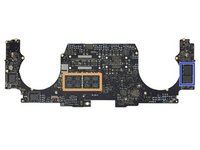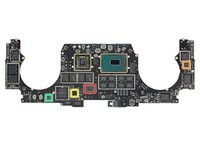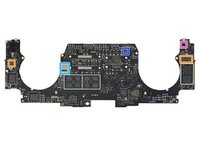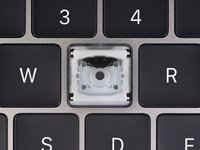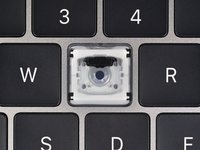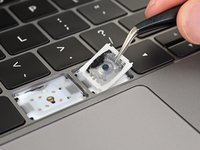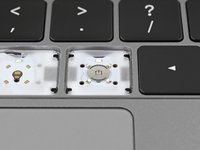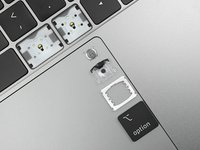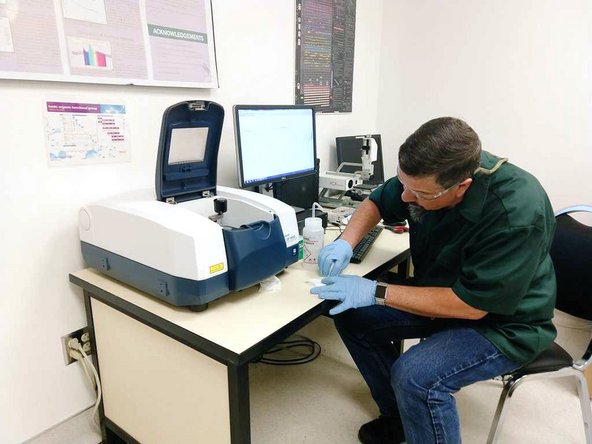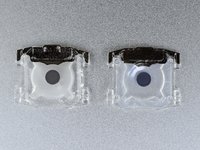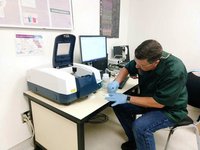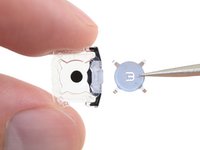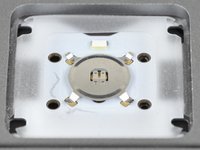Introduction
Apple’s newest MacBook Pro is its fastest yet, featuring an optional eight-core processor—a first in a MacBook—and a mysterious new keyboard material. Since it’s unlikely that Apple’s going to expound on this ‘material,’ and we’re never satisfied with an unsolved mystery, it’s time once again to take a closer look at the infamous butterfly keyboard. Put on your detective hat and join us for a teardown!
Looking for more thrilling teardown mysteries? Follow us on Facebook, Instagram, and Twitter for all the latest teardown news. For news delivered, sign up for our newsletter.
What you need
Video Overview
-
-
On paper, this new 2019 MacBook Pro is only a spec bump—but just how bumpy is it? Let's recap:
-
15.4" LED-backlit IPS Retina display with True Tone, 2880 x 1800 resolution (220 dpi), P3 wide color gamut
-
2.6 GHz 6-core Intel Core i7 (Turbo Boost up to 4.5 GHz) paired with a Radeon Pro 555X
-
16 GB of 2400 MHz DDR4 SDRAM
-
256 GB PCIe-based SSD
-
802.11ac Wi-Fi and Bluetooth 5.0
-
Four Thunderbolt 3 (USB-C) ports
-
-
-
With zero modular components, there's no chance of upgrading any of this hardware. Speak now or forever hold your chips:
-
9th-generation Intel Core i7-9750H 6-core processor
-
16x SK Hynix H5AN8G8NAFR 8 Gb DDR4 SDRAM (16 GB total)
-
AMD Radeon Pro 555X GPU
-
4x Micron MT51J256M32HF-70:B 8 Gb GDDR5 RAM (4 GB total)
-
Apple T2 APL1027 339S00533 coprocessor, layered over 1 GB Micron D9VLN LPDDR4 memory
-
Toshiba TSB3226AW8815TWNA1 and TSB3226XZ2939TWNA1 flash storage (256 GB total)
-
Intel JHL7540 Thunderbolt 3 controller
-
-
-
-
-
Onward to the keyboard! Let's recap this butterfly's metamorphosis so far.
-
After making its debut in the 2015 Retina MacBook, the butterfly keyboard landed on the MacBook Pro line for the first time in 2016 (pictured at left).
-
In summer of 2018, Apple launched a repair program, privately blaming dust for jamming the keys—and released updated models with a silicone membrane protecting the key switches (middle image). But problems have persisted.
-
Lastly, 2019's butterfly switch revision keeps the silicone membrane, but tweaks the materials in the springy metal dome and the plasticky material that covers it.
-
-
-
Now that we have some context, let's go layer by layer through the key components of 2019's butterfly switch:
-
Topping it all off is the key cap. This has a handy label to tell users which key is broken.
-
The hinged white bracket is the "butterfly" mechanism controlling the key's motion—stabilizing it so as to travel up and down without tilting or wobbling.
-
Nesting within that bracket is a transparent cover that flexes with each key press, while keeping contaminants away from the dome switch underneath. The black dot at its center concentrates the force of your key press onto the switch.
-
The main character of this assembly is the springy metal dome switch. It deforms when the key is pressed, bridging the board's six contacts—and then bounces back when you release the key.
-
Underneath the dome switch are six metal pads. A keystroke registers whenever the top center pad is shorted to any of the other five pads.
-
To wrap it up, the silicone membrane covers the butterfly mechanism to keep debris from getting in and jamming it.
-
-
-
So, what changed this year? First, the transparent switch cover material.
-
The cover in the 2018 model is semi-opaque, somewhat tacky, and feels like silicone. The new model is clearer and smooth to the touch.
-
To confirm that the materials are indeed different, we analyzed them using Fourier Transform Infrared (FTIR) spectroscopy. Thanks to Eric Beaton and Cal Poly's Materials Engineering department for their equipment and expertise!
-
The differing peaks and valleys on the FTIR spectra for the two samples show us that they are different materials. But what are they?
-
When comparing these FTIR spectra to that of known polymers, the closest match for the 2018 model is either poly(acetylene) with aromatic urethane side groups, or a type of TPU (which seems more likely). The 2019 model is a match for polyamide (commonly known as nylon).
-
-
-
What else changed? We think the metal dome switch may have. Let's look closer.
-
The dome is like a really tiny jam lid or Snapple cap—you press down and it springs back up.
-
If anything changes about the dome—if it's cracked or deformed—the key may behave erratically. Likewise, if the prongs break or bend, the key stops working.
-
It's entirely possible that several of these factors are contributing to switch failures, which could explain why Apple is having such a hard time untangling the problem. Fourth time's the charm?
-
- The trackpad can be removed and replaced with very little drama.
- The processor, RAM, and flash memory are soldered to the logic board. Repairs and upgrades will be impractical at best.
- The top case assembly, including the keyboard, battery, speakers, and Touch Bar, is glued together—making all those components impractical to replace separately.
- The Touch ID sensor doubles as the power switch, and is paired with the T2 chip on the logic board. Fixing a broken power switch may require help from Apple, or a new logic board.
Final Thoughts
Repairability Score


(10 is easiest to repair)
28 Guide Comments
“When comparing these FTIR spectra to that of known polymers, the closest match for the 2018 model is polyacetylene with aromatic urethane side groups, while the 2019 model uses polyamide (commonly known as nylon).
What this doesn't tell us is, just what problem Apple's engineers tried to solve using this updated material. Send us your ideas!”
Spitballing, any debris would have an easier time sliding through the nylon, while the 2018 model has a more sticky material.
Hopefully making cleaning with canned air more effective.
Mark -
The plastic dome covers the contacts so you can’t really blow air into the gap. The covers are glued down to the base 360 degrees.
DanJ -
Was eagerly anticipating this teardown as soon as the tech press announced the new MacBook Pros with yet another keyboard iteration.
Question: How are the butterfly mechanism and plastic cover attached to the top case? Are they merely held in place by the silicone membrane?
I could not tell if the membrane had to be cut in order to extract the butterfly mechanism and plastic dome.
Those two keys you disassembled, can they be re-assembled and have them function normally without the key falling off?
The thing that really holds it all together is the clear plastic cover piece with the black dot in the middle. That component both holds the dome in place on the PCB and provides the pivot points for the hinged white bracket that controls the keycap travel. Unfortunately, it’s essentially riveted in place from the back with plastic pegs, and prying it out is usually pretty destructive. (In other words, don’t try this at home!) The silicone dust membrane doesn’t have to be cut however, as it’s mainly around the perimeter and not over the top of the mechanism.













